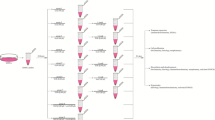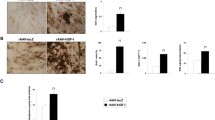Summary
The feasibility of using gene therapy to treat full-thickness articular cartilage defects was investigated with respect to the transfection and expression of exogenous transforming growth factor (TGF)-β1 genes in bone marrow-derived mesenchymal stem cells (MSCs)in vitro. The full-length rat TGF-β1 cDNA was transfected to MSCs mediated by lipofectamine and then selected with G418, a synthetic neomycin analog. The transient and stable expression of TGF-β1 by MSCs was detected by using immunohistochemical staining. The lipofectamine-mediated gene therapy efficiently transfected MSCsin vitro with the TGF-β1 gene causing a marked up-regulation in TGF-β1 expression as compared with the vector-transfected control groups, and the increased expression persisted for at least 4 weeks after selected with G418. It was suggested that bone marrow-derived MSCs were susceptible toin vitro lipofectamine mediated TGF-β1 gene transfer and that transgene expression persisted for at least 4 weeks. Having successfully combined the existing techniques of tissue engineering with the novel possibilities offered by modern gene transfer technology, an innovative concept, i.e. molecular tissue engineering, are put forward for the first time. As a new branch of tissue engineering, it represents both a new area and an important trend in research. Using this technique, we have a new powerful tool with which: (1) to modify the functional biology of articular tissue repair along defined pathways of growth and differentiation and (2) to affect a better repair of full-thickness articular cartilage defects that occur as a result of injury and osteoarthritis.
Similar content being viewed by others
References
Grande D, Breitbart A, Mason Jet al. Cartilage tissue engineering: current limitations and solutions Clin Orthop, 1999, 367S:S176
Brittberg M, Lindahl A, Nilsson Aet al. Treatment of deep cartilage defects in the knee with autologous chondrocyte transplantation. N Engl J Med, 1994, 331:889
Reddi A. Morphogenesis and tissue engineering of bone and cartilage: inductive signals, stem cells, and biomimetic biomaterials. Tissue Eng, 2000, 6(4):351
Freed L, Martin I, Vunjak-Novakovic G. Frontiers in tissue engineering: in vitro modulation of chondrogenesis. Clin Orthop, 1999, 367S:S46
Evans C, Ghivizzani S, Smith Pet al. Using gene therapy to protect and restore cartilage. Clin Orthop, 2000, (379 Suppl):S214
Fernandes J, Martel-Pelletier J, Pelletier J. Gene therapy for osteoarthritis: new perspectives for the twenty-first century. Clin Orthop, 2000, (379 Suppl): S262
Mason J M, Breitbart A S, Barcia Met al. Cartilage and bone regeneration using gene-enhanced tissue engineering. Clin Orthop, 2000, (379 Suppl):S171
Guo X D, Du J Y, Zheng Q Xet al. Molecular tissue engineering: applications for modulation of mesenchymal stem cells proliferation by transforming growth factorβ1 gene transfer. J Tongji Med Univ, 2001, 21(4):177 2000.
Liu Y, Zheng Q X, Du J Yet al. Cloning and expression of rat transforming growth factorβ1 cDNA in osteoblasts. J Tongji Med Univ, 2000, 20(1):63
Johnstone B, Yoo J. Autologous mesenchymal progenitol cells in articular cartilage repair. Clin Orthop, 1999, 367S:S156
Yoo J, Mandell I, Angele Pet al. Chondrogenitor cells and gene therapy. Clin Orthop, 2000, (379 Suppl):S164
Caplan A I. Mesenchymal stem cells and gene therapy. Clin Orthop, 2000, (379 Suppl):S67
Arai Y, Kubo T, Kobayashi Ket al. Adenovirus vectormediated gene transduction to chondrocytes: in vitro evaluation of therapeutic efficacy of transforming growth factor-β1 and heat shock protein 70 gene transduction. J Rheumatol, 1997, 24(9):1787
Llull R. Immune considerations in tissue engineering. Clin Plast Surg, 1999, 26(4):549
Kang R, Marui T, Ghivizzani Set al. Ex vivo gene transfer to chondrocytes in full-thickness articular cartilage defects: a feasibility study. Osteoarthritis and Cartilage, 1997, 5:139
Author information
Authors and Affiliations
Additional information
GUO Xiaodong, male, born in 1970, Doctor in Charge
Rights and permissions
About this article
Cite this article
Xiaodong, G., Jingyuan, D., Qixin, Z. et al. Expression of transforming growth factor β1 in mesenchymal stem cells: Potential utility in molecular tissue engineering for osteochondral repair. Current Medical Science 22, 112–115 (2002). https://doi.org/10.1007/BF02857668
Received:
Published:
Issue Date:
DOI: https://doi.org/10.1007/BF02857668




